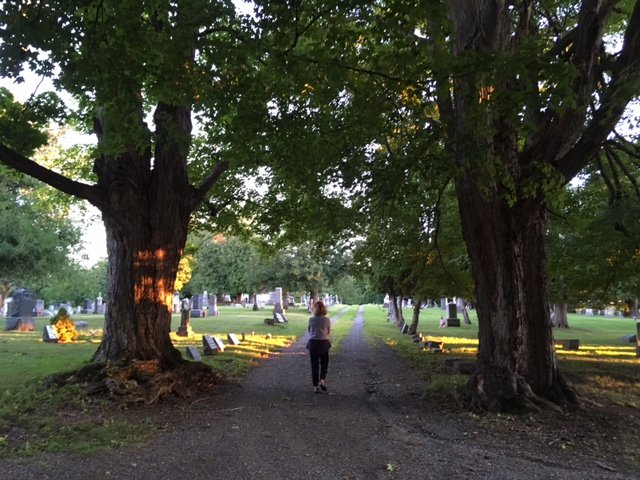A Return (Chatham Cemetery, August 2016)
IMG_2052
IMG_3277
IMG_3211
IMG_3266
My friend Beth lives across the street from the rural cemetery in the town of Chatham, in New York’s lush Hudson Valley. On summer visits from bone-dry L.A., it’s a balm to walk between the pair of centuries-old sentinel maples into the cemetery’s vast silent greenspace; to stroll the rows of mossy granite headstones, shaded by ancient hawthorns and oaks.I calibrate lifespans-- the gravestones of women whose lives ended in their twenties in childbirth or flu pandemic. I ponder those who lived across the cusp of centuries and savor the musicality of their names: TenBroek and Van Tassell, DeMoranville. I always visit the graves of the three veterans of the Union Army’s “Colored Infantry,” their names erased by wind and rain on stone. Small headstones mark births and deaths of children who succumbed perhaps to whooping cough, diphtheria—- sending my thoughts veering to front page photos: young children dying now in besieged Aleppo.
Usually when we walk, we’re the only ones there. A few days ago, we encountered a rare invasion: pick-ups parked along the gravel drive; young men with weed whackers cleaning around graves. What had summoned so many volunteers on a hot afternoon? A friendly matron collecting litter filled us in: a WW2 soldier was soon to return home. She pointed to a grave bedecked with small American flags where the remains of PFC George Traver, a Marine born in Chatham in 1918, will soon be re-interred from a mass grass on Tarawa, a coral atoll in the Pacific. Travers died there in November 1943, along with a thousand other Marines and some 4500 Japanese (most of whom fought to their death rather than surrender)-- in one of the most hideous battles of the Pacific War. Exposed to the heat, the bodies decomposed quickly and the Marines buried their dead in one large grave. A Florida-based group called History Flight discovered Traver’s remains along with 35 other fallen Marines in May 2015.New radar penetrating technology revealed the decades-old mass grave on Tarawa, and George’s remains were sent—with those of the other Marines—to an Army facility in Hawaii. They identified him by dental records and the Boy Scout knife in his pocket. He’d written to his mother requesting it, wanting to carry into battle a souvenir from home.George Traver will be buried next to his Gold Star mother, Nellie V. Cramer, who received a Western Union telegram on December 23, 1943: “Deeply regret to inform you that your son was killed in action in performance of his duty and in the service of his country.”Our now-tearful informant added that George’s mother waited thirty-five years for him, “until she couldn’t wait anymore.”
For the ceremony coming up on August 29th, she added, there would be “full military honors—a firing squad and all…” I knew she meant a twelve-gun salute.On our way back, we paused in front of the grave of another younger Chatham veteran, Joseph J, Wright. he was born in 1987, fought in Iraq, came home in 2012 and died two years later, in 2014. By mistake, the metal plaque from the government with his birth/death dates was delivered by FED EX to Beth’s doorstep on Cemetery Road. She searched out the young man’s obit, noting requested donations to the Wounded Warrior Project. The photo attached to this still-shiny headstone shows a handsome young man in uniform, “a beloved husband and father.”
At dinner that night, we were joined by a mutual friend who grew up in Germany. When we told her about Private Traver’s impending return, and the mother who waited 35 years, she recalled an image from her own childhood right after the war: her young aunt sitting by the radio each night, listening intently to Deutsches Roteskreuz, the German Red Cross broadcast, hope fading that her lost soldier husband had been found somewhere.
No matter the war, someone is waiting at home. I learned this when I made the trip to Japan in 1995 to return the flag my own father acquired in combat to the family of Yoshio Shimizu, who was twenty-one when he died. “You brought us back Yoshio,” one cousin told me. “The government just sent sand in a box.”
On today’s early morning walk, I followed the path by the cemetery pond, surprising a great blue heron who took wing towards the cemetery’s new Jewish section. There are only a few graves so far, all recent. On the headstone of Saul Cohen, someone’s “beloved father and grandfather”—his kindred have left copious small stones—as is the custom. The summer sky is blue with voluminous moving clouds. Crows chant sporadically from the high branches of the elms, the dead sleep their sleep and soon—after long delay, and in this long summer of our national discomfort. Private First Class George Traver, a native of this town, will join them.



